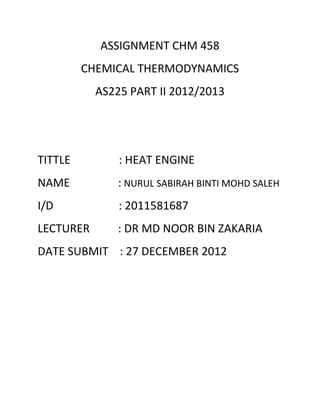
thermodynamic chemistry-heat engine
- 1. ASSIGNMENT CHM 458 CHEMICAL THERMODYNAMICS AS225 PART II 2012/2013 TITTLE : HEAT ENGINE NAME : NURUL SABIRAH BINTI MOHD SALEH I/D : 2011581687 LECTURER : DR MD NOOR BIN ZAKARIA DATE SUBMIT : 27 DECEMBER 2012
- 2. INTRODUCTION TO ZEROTH LAW,FIRST ,SECOND ,AND THIRD LAW OF THERMODYNAMICS ZEROTH LAW The zeroth law states that if two systems are in thermal equilibrium with a third system, they are also in thermal equilibrium with each other.It can also be defined as that if two systems, A and B, are in thermal equilibrium with a third system, C, then A and B are in thermal equilibrium with each other. FIRST LAW OF THERMODYNAMICS First law of thermodynamics state that energy cannot be destroyed or created.It shows the principles of conservation of energy. SECOND LAW OF THERMODYNAMICS Second law of thermodynamics state that the entropy of an isolated system never decreases, because isolated systems spontaneously evolve towards thermodynamic equilibrium. THIRD LAW OF THERMODYNAMICS The third law of thermodynamics is stated as the entropy of a perfect crystal at absolute zero Kelvin is exactly equal to zero. Now what I am going to do in this assignment is based on these 4 laws of thermodynamics.I’m using my own car engine to be a model for the heat engine.I have study all 4 laws and I am going to relate them to my car’s engine. The type of engine that I am using is 1.3 litre K3-VE engine with four in-line cylinders; both engines employ Dynamic Variable Valve Timing (DVVT) systems and conventional electronic fuel injection (EFI).
- 3. Hot air region or This is an overview of outer part of engine hot reservoir at Th Engine This is what happened in the cold reservoir, Th Heat engine is a system that performs the conversion of heat or thermal energy to mechanical work. It does this by bringing a working substance from a high temperature state to a lower temperature state. A heat "source" generates thermal energy that brings the working substance to the high temperature state. Carnot Cycle occur here (1st law of thermodynamics)
- 4. HOW I RELATE THOSE LAWS IN THE CAR ENGINE FOR FIRST LAW-CARNOT CYCLE Carnot heat engine consists of 5 main parts that is cylinder,source,sink,working substance and an insulating pad.Cylinder,which is the main part of the carnet engine has insulating walls and conducting base.It is suited with a perfectly insulated and frictionless piston.Source,the source is a very hot body maintain at a peaks higher temperature and has infinite thermal capacity.By infinite thermal capacity we mean that any amount of heat can be taken out of it withut changing the temperature of the source.Sink,is a body at low temperature, T2 also has infinite thermal capacity that is any amount of heat can be added to it without changing its temperature.Working substance,it is the ideal gas which absorb heat from the source,does some mechanical work and recheck the remaining amount of heat into the sink.Insulating pad or insulating stand,during the operation the Carnot cycle,working substances undergo adiabatic expansion and adiabatic compression.The cylinder is placed on insulating pad which is thermally isolated working substance from the surrounding.To continue supply work,the working substance is taken to the series of operating system called the Carnot cycle.The Carnot cycle consist of two reversible isothermal and adiabatic processes.Carnot Cycle is obtain when ideal gas is used as the working substance.The ideal gas is taken inside the cylinder to the piston. FOR SECOND LAW Second law gives the direction of the heat flow that are from hot region which is high energy to cold region which is low energy.Heat energy is never completely converted to mechanical energy that is efficiency of the heat engine is never equal to 100%.Efficiency of an engine can be defined as the ratio of external work done to the amount of heat absorbed from the source.There are two types of engine which is external combustion engine and internal combustion engine.For this car engine is internal petrol engine.Heat flow from hot reservoir to cold reservoir.This is how second law is applied. FOR THIRD LAW In heat engine,third law is applied when